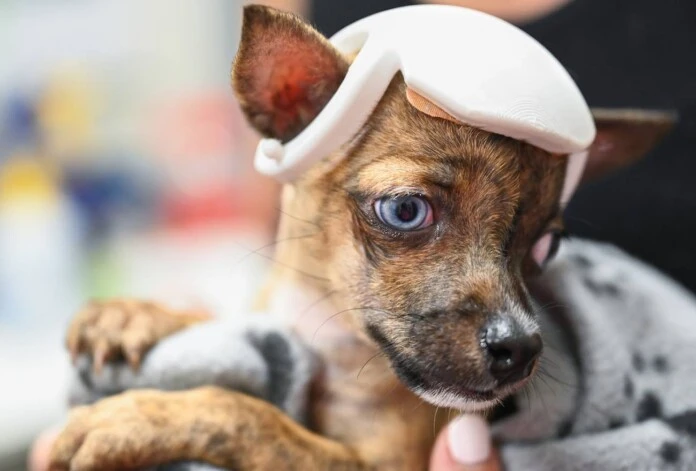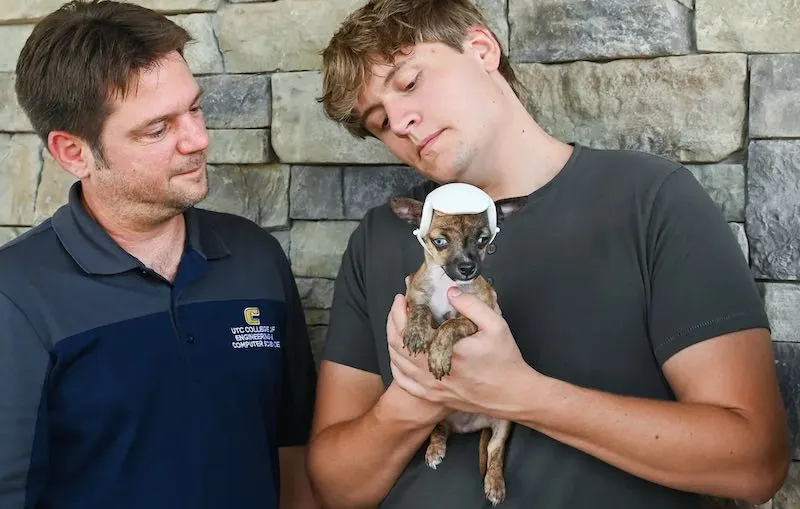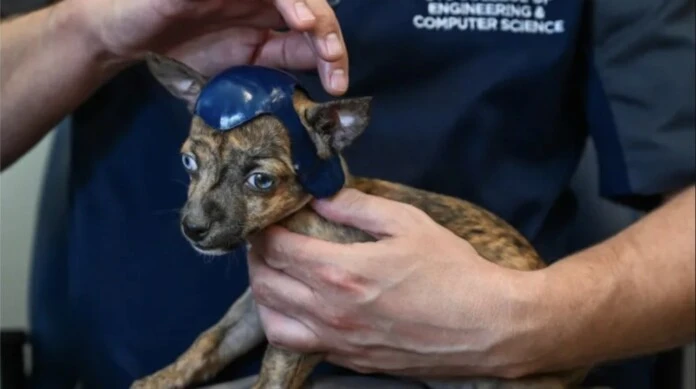When a call went out for assistance for a puppy needing special care, a faculty member at the University of Tennessee at Chattanooga and a recent graduate responded enthusiastically.
About a month ago, a tiny 2.5-pound Chihuahua named Niblet won the hearts of animal shelter staff even before it was discovered that he had a unique medical condition requiring special attention. Niblet had a soft spot on the top of his head, approximately one and a half centimeters in diameter, indicating his skull had not fully fused.
The Humane Educational Society (HES) reached out to mechanical engineering professor Trevor Elliott with an unusual request for help.
Niblet’s condition, hydrocephalus (water on the brain), makes even minor household accidents potentially life-threatening.
“We started brainstorming how to protect his head,” recalled HES Director of Veterinary Services Sarah Callahan.
Dr. Samantha Blair mentioned her contacts at the university. A few phone calls later, the engineering department provided a glimmer of hope for the 10-week-old puppy.
“When we realized we needed to make a cap, I remembered the amazing 3D printing capabilities of the graduate students,” said Blair.
Professor Elliott, upon learning about Niblet’s situation, felt an immediate need to help and arrived that very afternoon. “As soon as I saw his cute little face, I said, ‘We’ve got to help.'”
He enlisted the aid of Connor Mackey, a recent graduate who led the 2024 UTC Rocket Mocs team to win the 3D Printing Award at the NASA Student Launch competition—Mackey was fully on board.
“As soon as I saw the email chain, I knew exactly how to do this. I knew I could help this dog,” said Mackey, who is set to begin his Masters in Engineering at UTC this fall.
Elliott also sought the help of Volkswagen’s Justin Stephens to scan Niblet’s head to create a 3D image. He and Mackey then developed different designs for Niblet’s headgear; Mackey’s resembled a football helmet, while Elliott’s was more like a skull cap.
After several iterations, they met with Niblet at HES on July 15 to fit him with the protective headgear. Niblet quickly took to the football helmet design.
“It’s just kind of crazy what you can do,” Mackey said. “It was honestly a very simple process of getting a scan and then modeling around that. It’s really cool that you can save a dog’s life using this kind of manufacturing process.”

Elliott added, “It was pretty cool to see him walking around with it and knowing that at least one of our solutions is going to help him on his journey.”
“Fitting a puppy with protective headgear is new territory for us,” said Callahan, who is hopeful it will be the solution. “We really do think that he’s in the best possible place to have a good outcome and the longest life he can in a happy home.”
Caroline Smith, HES director of animal protection services, praised how quickly everyone rallied to support Niblet.

“Sometimes in this line of work, you don’t always get happy endings, so it’s nice to see everyone come together to help an animal,” Smith said. “This definitely took a lot of teamwork running with this idea—and we’re so thankful to UTC for stepping in to help.” Without the helmet, Niblet would have needed more than a cat’s nine lives to survive—but with it, he can live a good, long one.
